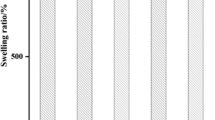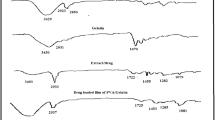Abstract
A novel composite hydrogel was prepared by combining polyvinyl alcohol (PVA) and sodium alginate (SA) in a specific proportion to serve as a drug carrier, and then loading the extract of Thesium chinense (TCE) onto the drug carrier for use in the trauma treatment. The morphology, structure and biological activity of PVA hydrogel, PVA/SA hydrogel and PVA/SA-TCE hydrogel were characterized, and their wound healing effects on SD rats were investigated. The results show that at a PVA content of 5 wt% and a SA content of 0.6 wt%, the swelling rate of PVA/SA-TCE hydrogel reached 1351 ± 32.0%, indicating excellent liquid absorption and permeation capabilities. When loaded with 2 mg/mL of TCE, PVA/SA-TCE hydrogel exhibited no cytotoxicity and achieved a drug release rate of over 50% at 24 h in buffer solutions with different pH values. Additionally, PVA/SA-TCE hydrogel demonstrated superior anti-inflammatory, antioxidant and antibacterial properties compared to PVA and PVA/SA hydrogels. It effectively prevented the infiltration of Escherichia coli and Staphylococcus aureus, reducing the risk of bacterial infection. In SD rats with full cortical incision, the application of PVA/SA-TCE hydrogel was found to promote wound healing significantly. The wound healing rate on the 20th day reached 99.7%, which was notably higher than that of the control group.
Graphical abstract














Similar content being viewed by others
References
Kamoun EA, Kenawy ES, Chen X (2017) A review on polymeric hydrogel membranes for wound dressing applications: PVA-based hydrogel dressings. J Adv Res 8(3):217–233. https://doi.org/10.1016/j.jare.2017.01.005
Rozza AL, Beserra FP, Vieira AJ et al (2021) The use of menthol in skin wound healing-anti-inflammatory potential, antioxidant defense system stimulation and increased epithelialization. Pharmaceutics 13(11):1902. https://doi.org/10.3390/pharmaceutics13111902
Han G, Ceilley R (2017) Chronic wound healing: a review of current management and treatments. Adv Ther 34(3):599–610. https://doi.org/10.1007/s12325-017-0478-y
Yazarlu O, Iranshahi M, Kashani HRK et al (2021) Perspective on the application of medicinal plants and natural products in wound healing: a mechanistic review. Pharmacol Res 174:105841. https://doi.org/10.1016/j.phrs.2021.105841
Liu C, Li XT, Cheng RR et al (2018) Anti-oral common pathogenic bacterial active acetylenic acids from Thesium chinense Turcz. J Nat Med 72(2):433–438
Chen PY, Chen XQ, Wu C et al (2020) Progress in the development and utilization of Thesium chinense Turcz. Chin Wild Plant Resour 39(6):48–52. https://doi.org/10.3969/j.issn.1006-9690.2020.06.010
Tang X, Yuan Y, Wang L et al (2021) Identifying prioritized planting areas for medicinal plant Thesium chinense Turcz under climate change in China. Ecol Inform 66:101459
Lingling Z, Ruifen J, Hongliang H et al (2022) Determination of five kinds of flavonoids in the medicinal herbs of Thesium chinensis. Chin Agric Sci Bull 38(5):30–36
Weidong X, Zhengping F, Shuigen H et al (2018) Study on hydrophilic chemical constituents from Thesium Chinensis Turcz. J Pharmaceutical Pract 36(3):270–273. https://doi.org/10.3969/j.issn.1006-01112018.03.017
Yi Z, Min H, Xiaofang Y (2016) Isolation of chemical components form Thesium chinense. Chin J Exp Tradit Med Formul 22(7):74–77. https://doi.org/10.13422/j.cnki.syfjx.2016070074
Li GH, Fang KL, Yang K et al (2021) Thesium chinense Turcz: an ethnomedical, phytochemical and pharmacological review. J Ethnopharmacol 273:113950
Parveen Z, Deng Y, Saeed MK et al (2007) Antiinflammatory and analgesic activities of Thesium chinense Turcz extracts and its major flavonoids, kaempferol and kaempferol-3-O-glucoside. Yakugaku Zasshi 127(8):1275–1279. https://doi.org/10.1248/yakushi.127.1275
Yongsong L, Man L, Ling P et al (2006) Progress in research active components of Thesium chinense Turcz. Progr Pharmaceutical Sci 30(6):252–255
Bing S (2017) Observation on the clinical effect of thymus tablet in the treatment of respiratory system infection. Chin J Clin Ratl Drug Use 10(10A):56–57
Jun Y, Dahai T, Weidong X et al (2015) Therapeutic effects of Thesium Chinesis extracts on IgAN rats. J Pharma Pract 33(1):28–31. https://doi.org/10.3969/j.issn.1006-0111.2015.01.007
Comotto M, Saghazadeh S, Bagherifard S et al (2019) Breathable hydrogel dressings containing natural antioxidants for management of skin disorders. J Biomater Appl 33(9):1265–1276. https://doi.org/10.1177/08853282188165
Winter GD (1962) Formation of the scab and the rate of epithelization of superficial wounds in the skin of the young domestic pig. Nature 193:293–294
Ecaterina SD (2014) Design and applications of interpenetrating polymer network hydrogels: a review. Chem Eng J 243:572–590. https://doi.org/10.1016/j.cej.2014.01.065
Wanying C, Jianping G, Jingjun M (2022) Research progress of sodium alginate composite hydrogel. J Beijing Inst Fash Technol 42(4):101–108. https://doi.org/10.16454/j.cnki.issn.1001-0564.2022.04.014
Koehler J, Wallmeyer L, Hedtrich S et al (2017) pH-Modulating poly(ethylene glycol)/alginate hydrogel dressings for the treatment of chronic wounds. Macromol Biosci. https://doi.org/10.1002/mabi.201600369
Li Y, Fu R, Zhu C et al (2021) An antibacterial bilayer hydrogel modified by tannic acid with oxidation resistance and adhesiveness to accelerate wound repair. Colloids Surf B Biointerfaces 205:111869. https://doi.org/10.1016/j.colsurfb.2021.111869
Chauhan N, Gupta P, Arora L et al (2021) Dexamethasone-loaded, injectable pullulan-poly(ethylene glycol) hydrogels for bone tissue regeneration in chronic inflammatory conditions. Mater Sci Eng C 130:112463
Jridi M, Sellimi S, Lassoued KB et al (2017) Wound healing activity of cuttlefish gelatin gels and films enriched by henna (Lawsonia inermis) extract. Colloids Surf, A 512:71–79. https://doi.org/10.1016/j.colsurfa.2016.10.014
Styrczewska M, Kostyn A, Kulma A et al (2015) Flax fiber hydrophobic extract inhibits human skin cells inflammation and causes remodeling of extracellular matrix and wound closure activation. Biomed Res Int 2015:862391
Boodhoo K, de Swardt D, Smith C et al (2021) Ex vivo tolerization and M2 polarization of macrophages dampens both pro- and anti-inflammatory cytokine production in response to diabetic wound fluid stimulation. Biochimie 196:143–152. https://doi.org/10.1016/j.biochi.2021.12.009
Permana AD, Mir M, Utomo E et al (2020) Bacterially sensitive nanoparticle-based dissolving microneedles of doxycycline for enhanced treatment of bacterial biofilm skin infection: a proof of concept study. Int J Pharmaceutics. https://doi.org/10.1016/j.ijpx.2020.100047
Kaltalioglu K, Balabanli B, Coskun-Cevher S (2020) Phenolic, antioxidant, antimicrobial, and in-vivo wound healing properties of Potentilla erecta L. root extract in diabetic rats. Iran J Pharmaceutical Res 19(4):264–274. https://doi.org/10.22037/ijpr.2019.112411.13742
Barreto AS, de Souza Siqueira Barreto R, de Souza Siqueira Quintans J et al (2013) Wound healing effect of TENS in rodents. Wiley, Hoboken
Jianhua Y, Xiao Y, Xiaopeng W et al (2018) Experimental study on shikonin promoting wound healing in rats. J Biomater Tissue Eng 8(12):1681–1686. https://doi.org/10.1166/jbt.2018.1931
Kretschmer M, Rudiger D, Zahler S (2021) Mechanical aspects of angiogenesis. Cancers 13(19):4987. https://doi.org/10.3390/cancers13194987
Xuan X, Zhou Y, Chen A et al (2020) Silver crosslinked injectable bFGF-eluting supramolecular hydrogels speed up infected wound healing. J Mater Chem B 8(7):1359–1370. https://doi.org/10.1039/C9TB02331C
Hussain T, Murtaza G, Yang H et al (2020) Exploiting anti-inflammation effects of flavonoids in chronic inflammatory diseases. Curr Pharm Des 26(22):2610–2619. https://doi.org/10.2174/1381612826666200408101550
Nunes MO, Goebel F, de Souza T, Pierdona TM et al (2021) In vitro biocompatibility and wound healing properties of latex proteins dressing. Toxicol Vitro 76:105230. https://doi.org/10.1016/j.tiv.2021.105230
Nayely L-L, Erick GG, Dulce AP et al (2016) Flavonoids as cytokine modulators: a possible therapy for inflammation-related diseases. Int J Mol Sci 17(6):921. https://doi.org/10.3390/ijms17060921
Acknowledgements
The authors would like to thank Prof. Tiantao Zhao for the great assistance, as well as Chongqing University of Technology for providing the financial support for this study via the National Natural Science Foundation of China (No.51978117).
Funding
This work was supported by the National Natural Science Foundation of China (No. 51978117).
Author information
Authors and Affiliations
Contributions
LZ contributed to conceptualization, methodology, analysis, funding, supervision and editing. MZ contributed to conceptualization, methodology, analysis and writing. WT, ZM and YZ contributed to conceptualization, supervision and editing. TZ contributed to funding, supervision and editing.
Corresponding author
Ethics declarations
Conflict of interest
The authors declare that they have no competing interests in this paper.
Ethical approval
No conflicts, informed consent, or human or animal rights are applicable to this study.
Additional information
Publisher's Note
Springer Nature remains neutral with regard to jurisdictional claims in published maps and institutional affiliations.
Supplementary Information
Below is the link to the electronic supplementary material.
Rights and permissions
Springer Nature or its licensor (e.g. a society or other partner) holds exclusive rights to this article under a publishing agreement with the author(s) or other rightsholder(s); author self-archiving of the accepted manuscript version of this article is solely governed by the terms of such publishing agreement and applicable law.
About this article
Cite this article
Zhang, L., Zhang, M., Tan, W. et al. Preparation and evaluation of Thesium chinense extract loaded polyvinyl alcohol/sodium alginate hydrogel for wound healing. Polym. Bull. 81, 6225–6247 (2024). https://doi.org/10.1007/s00289-023-04990-4
Received:
Revised:
Accepted:
Published:
Issue Date:
DOI: https://doi.org/10.1007/s00289-023-04990-4




